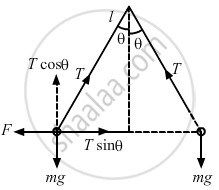Advertisements
Advertisements
प्रश्न
Two identical balls, each with a charge of 2.00 × 10−7 C and a mass of 100 g, are suspended from a common point by two insulating strings, each 50 cm long. The balls are held at a separation 5.0 cm apart and then released. Find.
(a) the electric force on one of the charged balls
(b) the components of the resultant force on it along and perpendicular to the string
(c) the tension in the string
(d) the acceleration of one of the balls. Answers are to be obtained only for the instant just after the release.
उत्तर
Given:
Magnitude of the charges, q = 2.0 × 10−7 C
Separation between the charges,
\[r = 5 \times {10}^{- 2} \]m
Length of the string,
\[l = 50 \text{ cm }= 50 \times {10}^{- 2}\] m
Mass of the balls, m = 100 g = 0.1 kg

(a) By Coulomb's Law, the electric force,
F = `("Kq"_1"q"_2)`
= `(9 xx 10^9 xx 2 xx 10^(-7) xx 2 xx 10^(-7))/((5 xx 10^(-2))^2)`
= `36/25 xx 10^(-1)`
= 0.144 N
(b) The components of the resultant force along it is zero because mg balances Tcosθ,as shown in the figure. So,
F = Tsinθ
⊥ to the string Fnet = fe cosθ − mg singθ
= `0.144(1) − 100/1000 xx 10 xx 1/20`
= `0.144 - 1/20`
= 0.094 N
(c) Tension in the string,
Tsinθ = F ..(1)
Tcosθ = mg ...(2)
Squaring equations (1) and (2) and adding, we get
\[T^2 = F^2 + \left( \text{mg } \right)^2 \]
\[ = \left( 0 . 144 \right)^2 + \left( 0 . 1 \times 9 . 8 \right)^2 \]
\[ \Rightarrow T^2 = 0 . 986\] N
(d) the acceleration of one of the balls
a = `"Fnet"/"m"`
= `0.094/0.1`
= 0.94 m/s2
APPEARS IN
संबंधित प्रश्न
Plot a graph showing the variation of coulomb force (F) versus ,`(1/r^2)` where r is the distance between the two charges of each pair of charges: (1 μC, 2 μC) and (2 μC, − 3 μC). Interpret the graphs obtained.
Find the dimensional formula of ε0.
Estimate the number of electrons in 100 g of water. How much is the total negative charge on these electrons?
Find the ratio of the electrical and gravitational forces between two protons.
Suppose an attractive nuclear force acts between two protons which may be written as F=Ce−kr/r2. Write down the dimensional formulae and appropriate SI units of C and k.
Three equal charges, 2.0 × 10−6 C each, are held at the three corners of an equilateral triangle of side 5 cm. Find the Coulomb force experienced by one of the charges due to the other two.
A hydrogen atom contains one proton and one electron. It may be assumed that the electron revolves in a circle of radius 0.53 angstrom (1 angstrom = 10−10 m and is abbreviated as Å ) with the proton at the centre. The hydrogen atom is said to be in the ground state in this case. Find the magnitude of the electric force between the proton and the electron of a hydrogen atom in its ground state.
A particle A with a charge of 2.0 × 10−6 C and a mass of 100 g is placed at the bottom of a smooth inclined plane of inclination 30°. Where should another particle B, with the same charge and mass, be placed on the incline so that it may remain in equilibrium?
Two particles A and B, each carrying a charge Q, are held fixed with a separation dbetween them. A particle C of mass m and charge q is kept at the middle point of the line AB. Under what conditions will the particle C execute simple harmonic motion if it is released after such a small displacement? Find the time period of the oscillations if these conditions are satisfied.
What are the differences between the Coulomb force and the gravitational force?
Three charges +Q, q, +Q are placed respectively, at distance, 0, d/2 and d from the origin, on the X-axis. If the net force experienced by +Q, placed at x = 0, is zero then value of q is ____________.
A force F acts between sodium and chlorine ions of salt (sodium chloride) when put 1 cm apart in air. The permittivity of air and dielectric constant of water are `epsilon_0` and K respectively. When a piece of salt is put in water, electrical force acting between sodium and chlorine ions 1 cm apart is ____________.
A charge Q is divided into two parts of q and Q – q. If the coulomb repulsion between them when they are separated is to be maximum, the ratio of Q/q should be ______.
A spring of spring constant 5 × 103 N/m is stretched initially by 5 cm from the unstretched position. Then the work required to stretch it further by another 5 cm is:
Coulomb's law is given by F = k q1q2 rn where n is
The capacity of an isolate conducting sphere of radius R is proportional to
